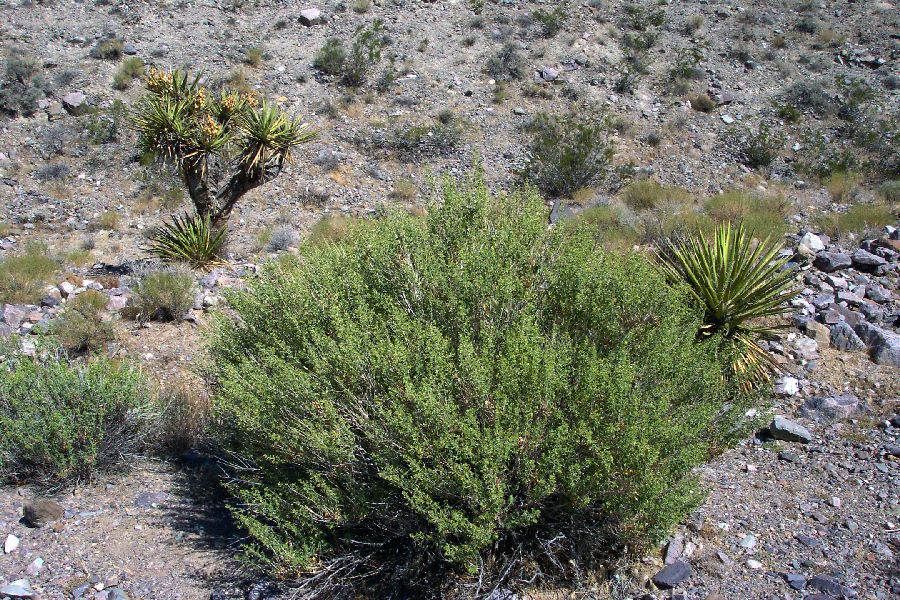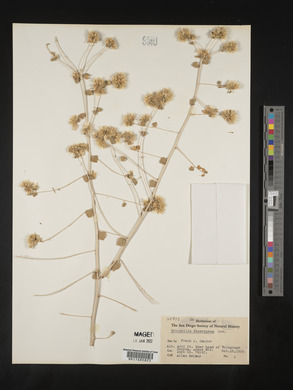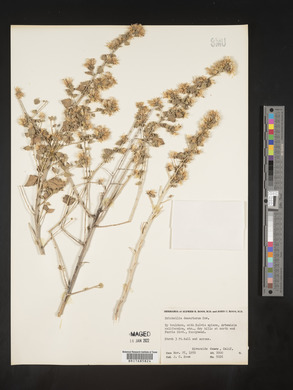Brickellia desertorum
|
|
|
|
Family: Asteraceae
Desert Brickellbush
[Brickellia californica var. desertorum (Coville) Parish ex Hall, moreColeosanthus desertorum (Coville) Coville] |
Shrubs, 80-200 cm. Stems intricately branched, densely puberulent, often gland-dotted. Leaves opposite or alternate; petioles 1-2.5 mm; blades 3-nerved from bases, ovate, 3-13 × 4-14 mm, bases obtuse to truncate, margins crenate-serrate, apices obtuse, faces gland-dotted and tomentulose to densely puberulent. Heads in paniculiform arrays. Peduncles 0-3 mm, gland-dotted. Involucres cylindric, 8-10 mm. Phyllaries 20-24 in 4-7 series, greenish or brownish, 3-4-striate, unequal, margins scarious (apices acute to apiculate); outer broadly ovate (granular-puberulent), inner lanceolate to lance-linear (glabrous or tomentulose, often gland-dotted). Florets 8-12; corollas white, 4.5-5 mm. Cypselae 2-3 mm, scabrous; pappi of 12-15 white, smooth or barbellulate bristles. Flowering Sep-Mar. Dry hillsides, outwash slopes, canyons; 200-1400 m; Ariz., Calif., Nev.; Mexico; West Indies; Central America (to Nicaragua). FNA 2006, Kearny and Peebles 1979, Scott 2014 (Jepson) Common Name: desert brickellbush Duration: Perennial Nativity: Native Lifeform: Shrub Wetland Status: UPL General: Shrubs, 80-200 cm tall; stems intricately branched, densely puberulent, often gland-dotted. Leaves: Opposite or alternate, on short petioles 1-2 mm long; blades 3-nerved from bases, ovate, 3-13 mm long and 4-14 wide, with obtuse to truncate bases, acute tips, and crenate-serrate margins; surfaces gland-dotted and tomentulose to densely puberulent. Flowers: Flower heads whitish, discoid, in pedunclutate clusters from leaf axils, the peduncles to 3 mm long, gland-dotted; involucre (ring of bracts wrapped around the flower head) cylindric, 8-10 mm high, the bracts (phyllaries) 20-24 in 4-7 series, greenish or brownish, unequal, striate, with scarious margins; florets 8-12, all discs, the corollas white, 5 mm high. Fruits: Achnes 2-3 mm long, scabrous, topped with a pappus of 12-15 white bristles. Ecology: Found on dry hillsides, outwash slopes, and canyons, below 4,500 ft (1372 m); flowers September-March. Distribution: AZ, CA, NV; south through MEX to C. Amer. and the West Indies. Notes: Brickellia is a genus of shrubs and perennial herbs with all disc flowers, these usually white to cream colored; flower heads wrapped in several rows of bracts (phyllaries), the outer rows shorter than the inner rows; and 10-nerved seeds topped with white tufts of bristles. B. desertorum is a shrubby low desert Brickellia found along the AZ-CA border, distinguished by the small ovate leaves about 1 cm long, with toothed edges; slender woody stems; and flower heads clustered on short peduncles toward the ends of branches. B. desertorm is quite similar to the more common and widespread B. californica, and in some treatments has been considered a variety of that species. The differences are in the leaves and phyllaries; B. desertorum has smaller, gray-green tomentose leaf blades 3-15 mm long, on shorter petioles less than 3 mm long, and minutely hairy phyllaries; while B. californica has, on average, larger, greener leaf blades 1-10 cm long, on longer petioles 5-60 mm long or more, and mostly glabrous phyllaries. Ethnobotany: Unknown, but other species in the genus have uses. Etymology: Brickellia is named for Dr. John Brickell (1749-1809), a botanist and physician who worked in Georgia; desertorum means it grows in deserts. Synonyms: Brickellia californica var. desertorum, Coleosanthus desertorum Editor: AHazelton 2015 |



















































































